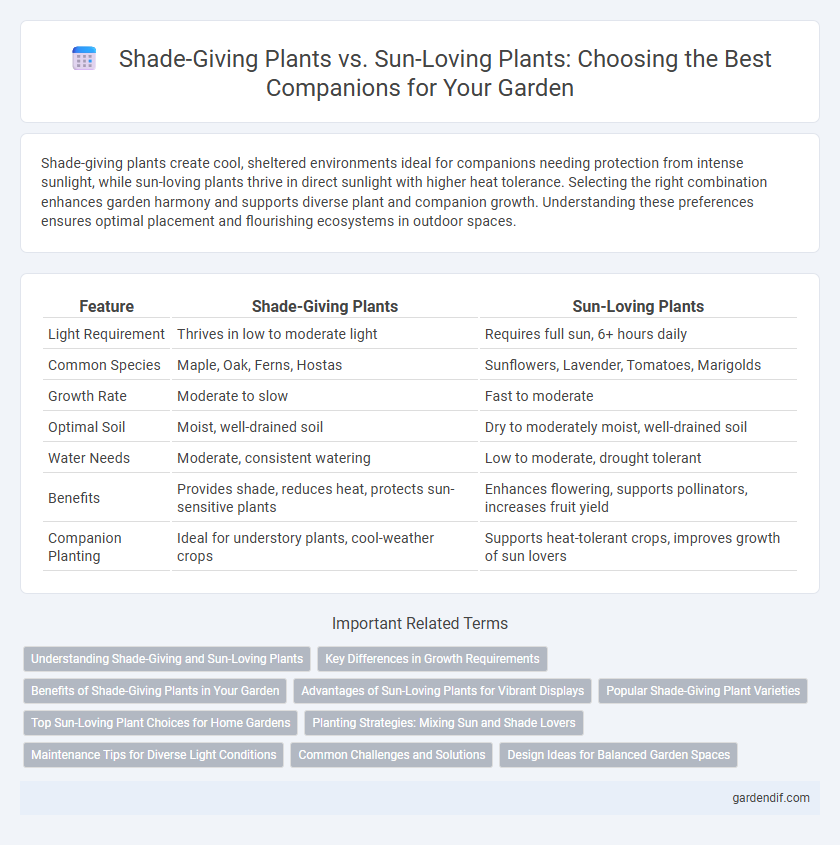
Shade-giving plants vs sun-loving plants Illustration
Shade-giving plants create cool, sheltered environments ideal for companions needing protection from intense sunlight, while sun-loving plants thrive in direct sunlight with higher heat tolerance. Selecting the right combination enhances garden harmony and supports diverse plant and companion growth. Understanding these preferences ensures optimal placement and flourishing ecosystems in outdoor spaces.
Table of Comparison
| Feature | Shade-Giving Plants | Sun-Loving Plants |
|---|---|---|
| Light Requirement | Thrives in low to moderate light | Requires full sun, 6+ hours daily |
| Common Species | Maple, Oak, Ferns, Hostas | Sunflowers, Lavender, Tomatoes, Marigolds |
| Growth Rate | Moderate to slow | Fast to moderate |
| Optimal Soil | Moist, well-drained soil | Dry to moderately moist, well-drained soil |
| Water Needs | Moderate, consistent watering | Low to moderate, drought tolerant |
| Benefits | Provides shade, reduces heat, protects sun-sensitive plants | Enhances flowering, supports pollinators, increases fruit yield |
| Companion Planting | Ideal for understory plants, cool-weather crops | Supports heat-tolerant crops, improves growth of sun lovers |
Understanding Shade-Giving and Sun-Loving Plants
Shade-giving plants, such as ferns and hostas, thrive in low-light environments and provide essential cover that protects sun-sensitive companions from excessive heat and UV exposure. Sun-loving plants like tomatoes and peppers require direct sunlight for at least six hours daily, optimizing photosynthesis and fruit production. Understanding the specific light requirements of companion plants enhances garden health, supports biodiversity, and maximizes yield by pairing shade-tolerant varieties with sun-demanding species strategically.
Key Differences in Growth Requirements
Shade-giving plants thrive in low-light conditions with consistent moisture, favoring cooler temperatures and well-drained, nutrient-rich soil. Sun-loving plants require full sunlight for at least six hours daily, needing higher heat levels and often exhibit drought tolerance with less frequent watering. Understanding these contrasting growth requirements is essential for optimal companion planting and garden design.
Benefits of Shade-Giving Plants in Your Garden
Shade-giving plants create a cooler microclimate in your garden, reducing soil temperature and moisture loss, which promotes healthier plant growth and conserves water. These plants protect delicate companions from intense sunlight, preventing wilting and sunburn while enhancing biodiversity by attracting beneficial insects and pollinators. Incorporating shade-giving species also improves soil structure and nutrient retention, leading to a more resilient and productive garden ecosystem.
Advantages of Sun-Loving Plants for Vibrant Displays
Sun-loving plants thrive in full sunlight, producing vibrant blooms that create eye-catching garden displays and attract pollinators like bees and butterflies. These plants often exhibit robust growth and extended flowering periods, enhancing visual appeal throughout the season. Their ability to withstand heat and direct sun exposure ensures consistent performance in bright, sunny locations, making them ideal companions for lively, colorful landscapes.
Popular Shade-Giving Plant Varieties
Popular shade-giving plant varieties include hostas, ferns, and azaleas, which thrive in low-light conditions and improve garden aesthetics with lush foliage and vibrant blooms. These plants effectively cool outdoor spaces by reducing direct sunlight exposure, making them ideal companions for sun-sensitive species and creating a balanced garden ecosystem. Choosing shade-loving varieties helps maintain soil moisture and supports biodiversity, enhancing overall garden health.
Top Sun-Loving Plant Choices for Home Gardens
Top sun-loving plants for home gardens include tomatoes, peppers, and marigolds, which thrive in full sun and enhance vegetable yields through companion planting. These plants require at least six to eight hours of direct sunlight daily to maximize growth and fruit production. Selecting sun-loving companions like basil or nasturtiums not only boosts pest resistance but also improves garden aesthetics and health.
Planting Strategies: Mixing Sun and Shade Lovers
Planting strategies that combine shade-giving plants with sun-loving plants optimize garden microclimates, enhancing overall plant health and growth. Shade-giving species such as Japanese maple or hosta create protective canopies that reduce sun intensity for sensitive sun-loving plants like lavender or rosemary, increasing moisture retention and stress tolerance. Strategically interspersing these plants ensures efficient space use, biodiversity support, and balanced light conditions vital for thriving companion planting systems.
Maintenance Tips for Diverse Light Conditions
Shade-giving companion plants like ferns and hostas thrive with consistent moisture and well-drained soil, requiring regular pruning to prevent overcrowding and ensure airflow. Sun-loving companions such as lavender and marigolds demand full sunlight, minimal watering, and occasional deadheading to promote continuous blooming. Adjusting care routines based on light exposure supports healthy growth and maximizes the benefits of diverse plant pairings in garden ecosystems.
Common Challenges and Solutions
Shade-giving plants often face challenges such as limited sunlight, leading to slower growth and increased susceptibility to mold or mildew. Solutions include selecting shade-tolerant companion plants like ferns or hostas and ensuring proper air circulation to reduce moisture buildup. Sun-loving plants require full sunlight and may suffer from leaf scorch or poor development when shaded, so placing them alongside taller companions that do not cast heavy shadows helps optimize light exposure and promotes healthy growth.
Design Ideas for Balanced Garden Spaces
Shade-giving plants such as ferns, hostas, and hydrangeas create cool, lush areas ideal for relaxation, while sun-loving plants like lavender, salvia, and marigolds add vibrant color and attract pollinators in bright spots. Strategic placement of these plants balances light exposure, enhances aesthetic variety, and supports diverse ecosystems within garden spaces. Combining shade-tolerant ground covers with sun-drenched flowering perennials maximizes spatial harmony and promotes healthy growth throughout the landscape.
Shade-giving plants vs sun-loving plants Infographic

 gardendif.com
gardendif.com